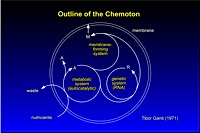The chemoton model was introduced by Tibor Gánti in 1971 as a fundamental unit model of living systems. It consists of three functionally dependent autocatalytic subsystems: the metabolic chemical network, the template polymerization and the membrane subsystem enclosing them all. The correct functioning of the chemoton relies on the precise stoichiometric coupling of these three subunits. It ensures that both the surface and the interior components dynamically increase to double their initial values, leading to the subsequent division of into two identical chemotons. Besides the detailed introductory papers of Gánti, only a few studies of this model exist in the literature, presenting however contradictory conclusions.
The study of the chemoton model in PACE aims toward a thorough survey of the chemoton's characteristics, such as replication period or optimal template length, in the parameters' space. Additionally, a comparative study between deterministic approach and the stochastic one has been performed. The chemoton model has also served as a guide for the second of the experimental approaches to constructng a minimal chemical artificial cell.






